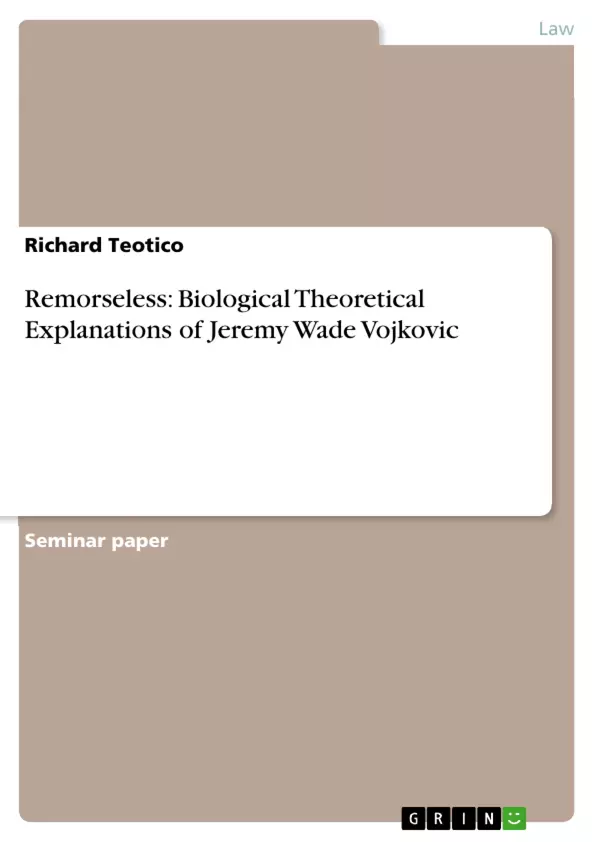(((From a first year Criminology 1100 class. A brief look into the biological, psychological, and sociological explanations of a brutal murder case in Canada.)))
Introduction
"Why?" Mrs. Findlay asked Jeremy Vojkovic, who attacked the mother of three minutes after she waved goodbye to her husband and children on a Tuesday morning 16 months ago. She posed the question after Mr. Vojkovic sexually assaulted her in the loft of the barn. He was putting her clothes back on and binding her wrists. Duct tape already covered her eyes. "It doesn't matter," Mr. Vojkovic replied. "Just be quiet" (Armstrong, 2004).
The Vojkovic case has enraged the hearts of many. The Findlay family, with strong social ties to the community, was dealt a devastating blow with the loss of Colleen Findlay. Upon the public hearing the accounts of what transpired, came about the discussion of the death penalty. The debate has slowly been gaining strength as a recent survey suggests that over sixty percent of British Columbian’s are in favor (Mackenzie, 2004). However, for this case, the public has only heard the accounts of what transpired on the day of the murder. Many people have passed judgment without considering the biological explanations for what occurred. Were these the actions of a cold and calculated murder or the manifestation of a teenager with impaired cognitive traits?
Table of Contents
- Introduction
- Biological Explanations
- Psychological Explanations
Objectives and Key Themes
This paper examines the biological theoretical explanations of Jeremy Wade Vojkovic's actions in the murder of Colleen Findlay. The primary objective is to analyze Vojkovic's behavior through the lens of two biological theoretical perspectives: Neuropsychological Theory and Cesare Lombroso's work on the “Born Criminal.”
- Biological and psychological factors in criminal behavior
- Neuropsychological theory and its application to the Vojkovic case
- Lombroso's theory of the "Born Criminal" and its relevance to the case
- The role of fetal alcohol syndrome in Vojkovic's behavior
- Limitations of biological and psychological theories in explaining the case
Chapter Summaries
Introduction
The paper introduces the case of Jeremy Wade Vojkovic, who attacked and murdered Colleen Findlay. It outlines the public's reaction to the crime and the ongoing debate surrounding the death penalty. The author argues that biological explanations for Vojkovic's behavior should be considered.
Biological Explanations
This section explores Lombroso's theory of the "Born Criminal," suggesting that Vojkovic, being of First Nations heritage, could be classified as a degenerate. The section also examines the potential influence of fetal alcohol syndrome on Vojkovic's actions. It highlights the limitations of both theories, particularly in the absence of evidence for fetal alcohol syndrome or visible abnormalities.
Psychological Explanations
This section analyzes Vojkovic's behavior through the lens of Lombroso's theory, highlighting his lack of remorse and apparent manipulative actions. It also explores the potential for brain damage as suggested by Neuropsychological Theory, linking it to inconsistencies in Vojkovic's actions and his poor verbal skills. The section acknowledges that these theories fail to address key aspects of Vojkovic's behavior, including potential pathological lying, family dynamics, and substance abuse.
Keywords
The key concepts in this paper are criminal behavior, biological explanations, Neuropsychological Theory, Cesare Lombroso's "Born Criminal" theory, fetal alcohol syndrome, psychological explanations, pathological lying, family dynamics, and substance abuse.
- Citar trabajo
- Bachelor of Arts Criminology and Psychology Richard Teotico (Autor), 2007, Remorseless: Biological Theoretical Explanations of Jeremy Wade Vojkovic, Múnich, GRIN Verlag, https://www.grin.com/document/210785



